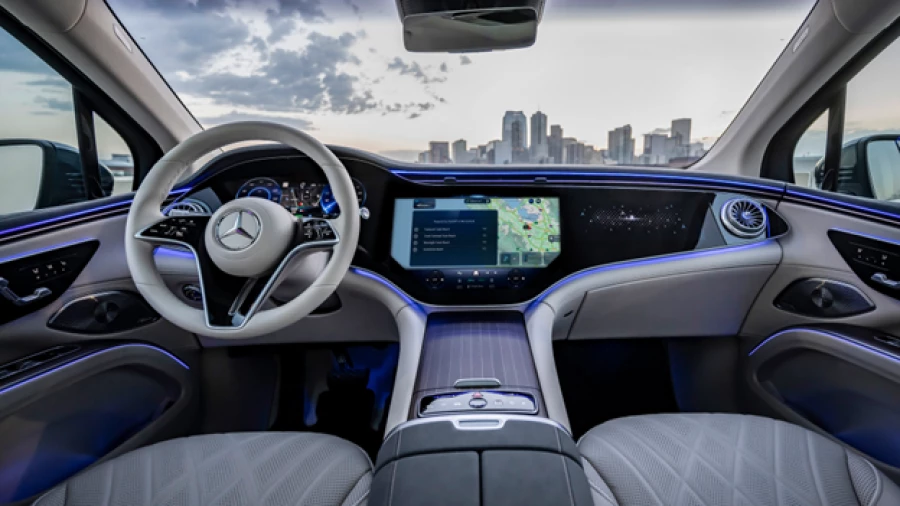
When I started driving in the 1990s, I thought I was living in the future. My first car had everything I thought I could ever need: a built-in radio, lighting when you opened the door, windows you could roll down with a crank, a clock and even air-conditioning for those really hot days growing up on the East Coast.
That car is long gone, but my passion for driving things forward lives on, which is why I’m excited to share how Mercedes-Benz is using Microsoft AI capabilities to enhance experiences for some drivers today.
As the last six months have shown us, the power of generative AI goes beyond cutting-edge language models—it’s what you build with it that matters most. Our Azure OpenAI Service lets companies tap into the power of the most advanced AI models (Open AI’s GPT-4, GPT-3.5, and more) combined with Azure’s enterprise capabilities and AI-optimized infrastructure to do extraordinary things.
Mercedes-Benz takes in-car voice control to a new level with Azure OpenAI Service
Today, Mercedes-Benz announced they are integrating ChatGPT via Azure OpenAI Service to transform the in-car experience for drivers. Starting June 16, drivers in the United States can opt into a beta program that makes the MBUX Voice Assistant’s “Hey Mercedes” feature even more intuitive and conversational. Enhanced capabilities include:
- Elevated voice command and interaction: ChatGPT enables more dynamic conversations, allowing customers to experience a voice assistant that not only understands voice commands but also engages in interactive conversations.
- Expanded task capability: Whether users need information about their destination, a recipe, or answers to complex questions, the enhanced voice assistant will provide comprehensive responses, allowing drivers to keep their hands on the wheel and eyes on the road.
- Contextual follow-up questions: Unlike standard voice assistants that often require specific commands, ChatGPT excels at handling follow-up questions and maintaining contextual understanding. Drivers can ask complex queries or engage in multi-turn conversations, receiving detailed and relevant responses from the voice assistant.
- Integration with third-party services: Mercedes-Benz is exploring the ChatGPT plugin ecosystem, which would open up possibilities for integration with various third-party services. This could enable drivers to accomplish tasks like restaurant reservations, movie ticket bookings, and more, using natural speech commands, further enhancing convenience and productivity on the road.
With the three-month beta program, Mercedes-Benz customers can become early adopters of this groundbreaking technology. Based on the findings of the beta program and customer feedback, Mercedes-Benz will consider further integration of this technology into future iterations of their MBUX Voice Assistant while maintaining the highest standards of customer privacy on and off the road.
With Microsoft, Mercedes-Benz is paving the way for a more connected, intelligent, and personalized driving experience, and accelerating the automotive industry through AI.
In case you missed it, at Microsft Build we recently announced updates to Azure OpenAI Service to help you more easily and responsibly deploy generative AI capabilities powered by Azure. You can now:
- Use your own data (coming to public preview later this month), allowing you to create more customized, tailored experiences based on organizational data.
- Add plugins to simplify integrating external data sources with APIs.
- Reserve provision throughput (generally available with limited access later this month) to gain control over the configuration and performance of OpenAI’s large language models at scale.
- Create safer online environments and communities with Azure AI Content Safety, a new Azure AI service integrated into Azure OpenAI Service and Azure Machine Learning prompt flow that helps detect and remove content from prompts and generation that don’t meet content management standards.
A responsible approach
Microsoft has a layered approach for generative models, guided by Microsoft’s responsible AI principles. In Azure OpenAI Service, an integrated safety system provides protection from undesirable inputs and outputs and monitors for misuse. In addition, Microsoft provides guidance and best practices for customers to responsibly build applications using these models and expects customers to comply with the Azure OpenAI Code of Conduct. With Open AI’s GPT-4, new research advances from OpenAI have enabled an additional layer of protection. Guided by human feedback, safety is built directly into the GPT-4 model, which enables the model to be more effective at handling harmful inputs, thereby reducing the likelihood that the model will generate a harmful response.
Get started with Azure OpenAI Service
- Apply now for access to Azure OpenAI Service.
- Bookmark the What’s New page.
- Review Azure OpenAI Service documentation.
- Explore the playground and customization in Azure AI Studio. No programming is required.
- Dive right in with QuickStarts.
- Watch the new explainer video about Azure OpenAI Service.
